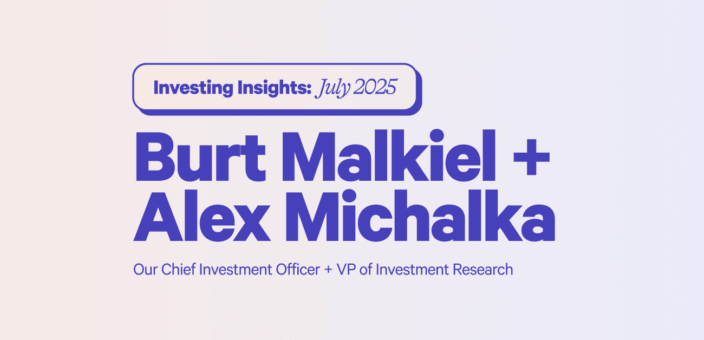Back in the spring, the stock market appeared to be in free-fall. From the April 2 “Liberation Day” tariff announcements to April 8, the S&P 500® dropped by about 12%. Then, on April 9, the S&P 500® had its best single-day gain in about 17 years. And by early summer, as the likely magnitude of the tariffs became somewhat clearer, the market came roaring back and recorded a new high by the end of June.
This episode of enormous short-term volatility illustrates how hard it is to get market timing right. To successfully time the market, you have to make two correct decisions: when to sell and when to buy again. It is impossible for anyone to do that consistently over the long term. In fact, by trying to do so, investors generally lower their investment returns—in part because markets can be unnervingly volatile both through the worst declines and the subsequent recoveries. As a result, it’s all too easy to miss the rebound and give up a significant portion of your return.
In this post, we’ll look at the historical evidence to show why market timing is such a costly strategy.
What happens when you sell during a market decline and wait for the market to recover?
During market volatility like what we witnessed earlier this year, it can be very tempting for investors to sell when markets are falling and wait for the recovery to invest again. We’ll start by showing why that approach doesn’t work.
For our analysis, we’ll use US stock market returns from Kenneth French’s data library over the 50-year period from June 1, 1976, to May 31, 2025. We’ll assume you received a salary at the end of each month, $100 of which you invested in the broad US stock market, and that any uninvested cash earns the risk-free rate (also sourced from Kenneth French’s data library). To keep things simple, we’ll ignore the impact of taxes.
The chart below shows what would have happened if you sold your investments each time the market fell 10%, 20%, 30%, 40%, or 50% below its previous one-year peak and invested everything again when the market fully recovered to that peak.
Even without seeing the data in the table, you might have been able to guess that you’d get bad results from selling in a decline and then getting back in when the market’s back at its peak. Investors want to “buy low” and “sell high”—and this approach is the opposite. But what might be surprising is just how bad the results are.
Because the general long-term trajectory of the market is upwards, being out of the market can have a significant cost—in the example above, that cost can literally be millions of dollars.
A less extreme example
The example above is fairly extreme, and so is the outcome. What if you took a more measured approach to timing the market and got back in when the market recovered halfway from its most recent trough? This approach allows for the possibility of success, because you could end up buying investments at a lower price than what you sold them for (selling high and then buying low). For instance, the chart below shows what this strategy would have looked like during the period from 2007-2010, if you sold when the market declined by 20%. In that case, you would get to sell your investments at a higher price than what you’d pay to buy them back. (Keep in mind that this wouldn’t always be the case, though—it just depends on how deep the decline ends up being.)
In practice, even this less extreme approach doesn’t work over time. You don’t get to “sell high” and “buy low” enough of the time to make up for your time out of the market. Let’s look at this approach over the same period we covered above from 1976 to 2025. The chart below shows how this strategy would play out if you sold each time there was a 10%, 20%, 30%, 40%, or 50% decline relative to the recent one-year peak from June 1, 1976, to May 31, 2025 (again, assuming you have $100 to invest at the end of each month and ignoring the impact of taxes). And in this less extreme example, you’d reinvest when the market recovered halfway from its most recent trough. Even when we look at this less extreme approach, you still get a far superior result just by staying in the market.
It’s very hard to time the market
As further evidence that timing the market is hard, consider how often the best days (those with the highest single-day returns) occur shortly after deep declines.
The table below shows the 10 best single-day returns for the total US stock market (again using data from Kenneth French’s data library) over the same time period. As you can see, every single one occurred following significant market declines. And in every case, three weeks or less had passed since the last “bad” day (defined as one of the worst 50 days—approximately 0.39%—in the period).
Short-term market volatility such as that depicted in the table above is why you can expect to earn money from investing over the long term. Your ability to tolerate volatility is why you have the opportunity to earn more. Put more simply: no pain, no gain. Taking on some risk offers you the possibility of earning more than the risk-free rate.
Your best bet is to buy and hold
Most investors probably don’t have rules like the ones we used in the examples in this post—instead, their decisions are likely emotional. But no matter what’s driving the behavior (selling in a decline and buying when the market appears to stabilize), the results are the same: you’re not likely to come out ahead when you try to time the market. The annual DALBAR Quantitative Analysis of Investor Behavior report shows this pattern year after year: investors’ behavior tends to lead to underperformance. In 2024 alone, DALBAR found that average investors in equities underperformed the S&P 500® by more than 8%.
This highlights the importance of having a portfolio that matches not only your investing time horizon and goals, but also your personal tolerance for risk. Even for two people with the exact same financial situation, the same portfolio might not be appropriate for both—one might be more risk averse and have more trouble staying invested. Ideally, you want a portfolio that can help you reach your financial goals and one that allows you to sleep at night.
Disclosure
The information contained in this communication is provided for general informational purposes only, and should not be construed as investment or tax advice. Nothing in this communication should be construed as a solicitation or offer, or recommendation, to buy or sell any security. The analysis presented is general educational information and market commentary provided for illustrative purposes only, and does not account for taxes, fees, inflation, or other factors that would impact actual returns, and does not reflect any client’s actual experience. Any links provided to other server sites are offered as a matter of convenience and are not intended to imply that Wealthfront Advisers or its affiliates endorses, sponsors, promotes and/or is affiliated with the owners of or participants in those sites, or endorses any information contained on those sites, unless expressly stated otherwise.
Investment management and advisory services are provided by Wealthfront Advisers LLC (“Wealthfront Advisers”), an SEC-registered investment adviser, and brokerage related products, including the Cash Account, are provided by Wealthfront Brokerage LLC (“Wealthfront Brokerage”), a Member of FINRA/SIPC. Financial planning tools are provided by Wealthfront Software LLC (“Wealthfront Software”).
Automated investing and diversification do not guarantee profit or ensure against loss. Investor experiences can vary widely based on strategies and time horizons. Index funds and ETFs generally offer broad diversification, but may still expose investors to specific market, sector, or asset class risks. Wealthfront provides investment management services but may not achieve returns comparable to those of the general market or specific benchmarks.
Wealthfront Advisers, Wealthfront Brokerage, and Wealthfront Software are wholly-owned subsidiaries of Wealthfront Corporation.
Copyright 2025 Wealthfront Corporation. All rights reserved.
About the author(s)
Alex Michalka, Ph.D, has led Wealthfront’s investment research team since 2019. Prior to Wealthfront, Alex held quantitative research positions at AQR Capital Management and The Climate Corporation. Alex holds a B.A. in Applied Mathematics from the University of California, Berkeley, and a Ph.D. in Operations Research from Columbia University. View all posts by Alex Michalka, Ph.D
Dr. Burton G. Malkiel, the Chemical Bank Chairman’s Professor of Economics, Emeritus, and Senior Economist at Princeton University, is Wealthfront's Chief Investment Officer. Dr. Malkiel is the author of the widely read investment book, A Random Walk Down Wall Street, which helped launch the low-cost investing revolution by encouraging institutional and individual investors to use index funds. Dr. Malkiel, also the author of The Elements of Investing, is one of the country’s leading investor advocates. View all posts by



